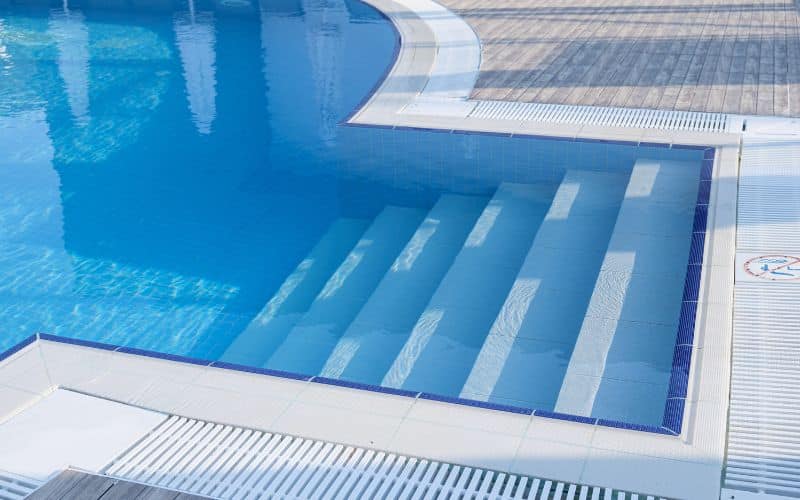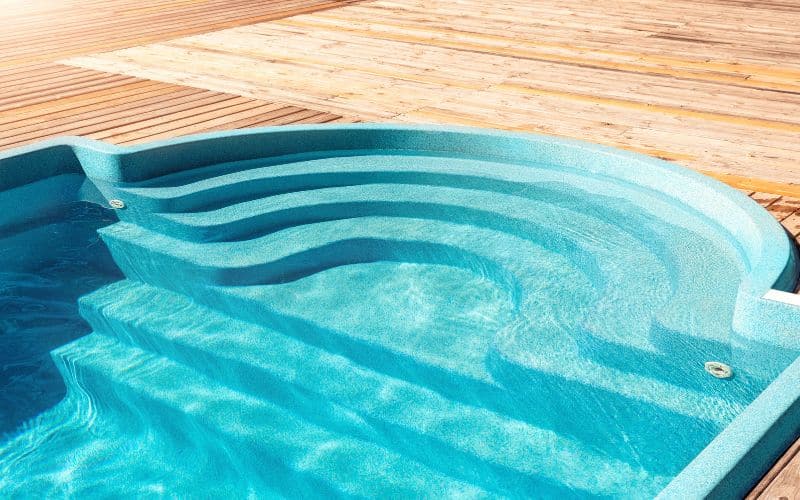
Considering a switch to a saltwater system for your fibreglass pool? You’re not alone. Saltwater swimming pools have been on the rise, thanks to their easy maintenance and the perceived benefits of swimming in salt water. But you might be wondering, can you use saltwater in a fibreglass pool?
The answer is, unequivocally, yes. Contrary to common misconceptions, saltwater is a fantastic choice for your fibreglass pool. This is due in part to the fact that fibreglass technology has advanced significantly over the years, making these pools highly resistant to the many harsh elements they’re exposed to, including saltwater.
However, it’s not all plain sailing. While the salt has no adverse effects on the shell of a fibreglass pool, you need to be aware of its potential to corrode other pool fixtures and features. It’s crucial to ensure these are adequately protected and that you’re using a saltwater generator that doesn’t over-treat. So let’s dive in, and explore the ins and outs of using saltwater in your fibreglass pool.
Is it Possible to Use Saltwater in a Fiberglass Pool?
Yes, it’s wholly possible to use saltwater in a fiberglass pool. Fiberglass pools are known for their high resistance to saltwater, making them an ideal choice for this type of system. A saltwater fiberglass pool requires less maintenance and work as compared to other pools. This is a significant advantage considering that you’d rather spend more time enjoying your pool than maintaining it.
Boats made of fiberglass, for instance, last a long time in marine water. This is because fiberglass holds up well against the various substances found in sea or ocean water. It’s the same case with fiberglass pools. The saltwater will not have any negative effect on your pool. In fact, salt has no adverse effects on the shell of a fibreglass pool which makes them highly compatible.
Fibreglass pool technology has advanced significantly over the years. These pools are designed to withstand various harsh elements, saltwater included. So, if you’re considering a saltwater system for your pool, a fiberglass pool is a great choice.
However, it’s crucial to remember that while the pool itself can handle saltwater, the area around your pool may not. Salt can build up and corrode objects that have metal or aluminium fittings. To prevent this, it’s best to wash down the area around your pool, including concrete, decking or equipment, with a hose after each use.
Moreover, while fibreglass is corrosion-resistant, other pool fixtures and features may not be. So, ensure they are protected, and you’re using a saltwater generator that’s effective and doesn’t over-treat.
Saltwater systems are increasingly popular for inground pools due to their lower maintenance requirements and the perceived benefits of swimming in salt water. But as with any decision, it’s important to consider all aspects before making a choice.
The Pros and Cons of Using Saltwater in a Fibreglass Pool
When considering a fibreglass pool, the decision to use saltwater can be a game-changer. Let’s delve into the pros and cons of using saltwater in a fibreglass pool.
Pros of Using Saltwater in a Fibreglass Pool
First and foremost, fibreglass pools are remarkably resistant to saltwater. This makes them a perfect candidate for a saltwater system. Here are some additional benefits:
- Less Maintenance: Saltwater systems are self-cleaning. They convert salt into chlorine, reducing the need for manual chlorine addition.
- Comfort: Saltwater is softer on the skin, causing less irritation and dryness.
- Cost-Effective: Although the initial cost of a saltwater generator can be high, you’ll save on the long-term cost of buying chlorine.
Cons of Using Saltwater in a Fibreglass Pool
While saltwater systems offer several benefits, there are a few disadvantages to keep in mind:
- Initial Cost: Saltwater generators can be pricey upfront. However, the long-term savings can offset this.
- Salt Corrosion: Salt can corrode certain types of metal and stone around your pool. It’s essential to rinse off any splashed areas to prevent damage.
- Over-Treatment: Some saltwater generators can over-treat, leading to high chlorine levels. It’s crucial to monitor your levels regularly to avoid this.
Remember, the decision to use saltwater in your fibreglass pool should be based on your personal preference and lifestyle. Consider the pros and cons carefully before making your decision. With proper care and maintenance, a saltwater fibreglass pool can offer years of enjoyment.

How to Convert Your Fiberglass Pool to a Saltwater System
Switching your fibreglass pool to a saltwater system might seem like a daunting task. But don’t let that deter you. It’s a process that can be broken down into simple steps.
Step 1: Test the Water
First things first, you’ve got to get a comprehensive picture of your pool’s current water chemistry. You’ll need to measure:
- pH levels
- Alkalinity
- Calcium hardness
- Cyanuric acid
- Salt levels (if any)
Remember: Accurate readings are key to ensuring a successful conversion!
Step 2: Balance the Pool Chemistry
Once you’ve got your readings, it’s time to balance the pool chemistry. You’ll want to aim for:
- pH levels between 7.2 and 7.8
- Alkalinity between 80 and 120 ppm
- Calcium hardness between 200 and 400 ppm
- Cyanuric acid levels between 30 and 50 ppm
Balancing the chemistry ensures the saltwater generator works efficiently and extends the life of your pool.
Step 3: Install a Salt Chlorine Generator
Next, you’ll need to install a salt chlorine generator. This device converts salt to chlorine, keeping your pool clean and safe for swimming. It’s best to hire a professional for installation to ensure it’s done correctly.
Step 4: Maintain the Salt Level
Finally, you’ll want to keep an eye on your salt levels. The typical salt level for a pool is between 2700 and 3400 ppm. You’ll need to add salt periodically to maintain these levels.
Pro Tip: Always add less salt than recommended. You can always add more if needed, but removing excess salt can be a hassle.
Tips for Maintaining a Saltwater Fibreglass Pool
Having a saltwater fibreglass pool can be a great addition to your outdoor space. But to keep it in top-notch condition, regular maintenance is vital. Let’s dive into some key tips to help you maintain your pool effectively.
Regular Cleaning and Maintenance
Regular cleaning and maintenance are crucial to prolong the life of your saltwater fibreglass pool. It’s important to constantly check for any visible signs of damage or wear. This could be anything from surface cracks to discolouration.
- Always maintain a balanced pH level to prevent corrosion or scaling.
- Regularly clean your pool filter.
- Check for leaks often and fix them immediately.
Monitoring the Salt Level
The salt level in your pool needs to be within the recommended range. Too much or too little salt can lead to a host of problems.
- The ideal salt level is between 2700 and 3400 parts per million (ppm).
- Invest in a good saltwater test kit for accurate readings.
- If you notice any extreme changes in salt levels, it could be a sign of a larger problem.
Proper Brushing and Vacuuming Techniques
Proper brushing and vacuuming of your pool are necessary to keep it clean and safe.
- Brush the pool walls at least once a week to dislodge any algae growth.
- Vacuum your pool regularly to remove any debris or dirt.
- Always use the right pool cleaning tools to avoid damaging the fibreglass surface.
Maintaining a saltwater fibreglass pool might seem daunting at first glance. But with a good maintenance routine, you can keep your pool sparkling clean and ready for a swim any time.

Conclusion
So, you’ve learned that it’s entirely possible to use saltwater in your fibreglass pool. You now understand that fibreglass pools are well-suited to saltwater because of their natural resistance. You’re aware of the lower maintenance requirements which can make your life easier. Yet, you’re also mindful of the initial costs and the potential for salt corrosion.
You’ve grasped the steps to convert your pool to a saltwater system. You know it’s crucial to balance the pool chemistry, install a salt chlorine generator, and keep an eye on the salt levels. You’re prepared to hire a professional for installation and to regularly check those salt levels.
You’re ready to commit to regular cleaning and maintenance, to use the right brushing and vacuuming techniques, and to keep your pool in the best possible condition. With these steps, you’re set to enjoy your saltwater fibreglass pool at any time. Now, all that’s left is to dive in and enjoy!








